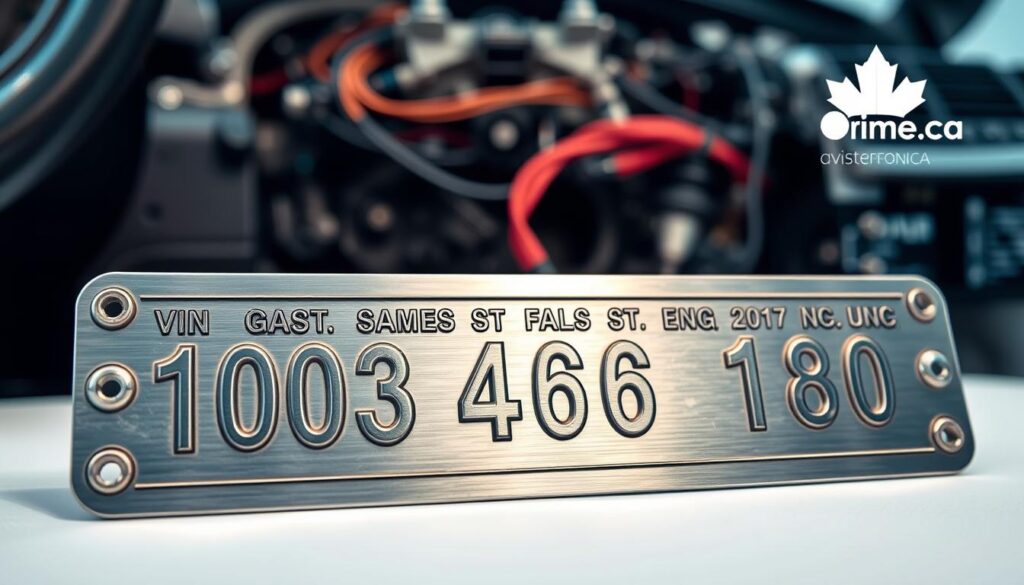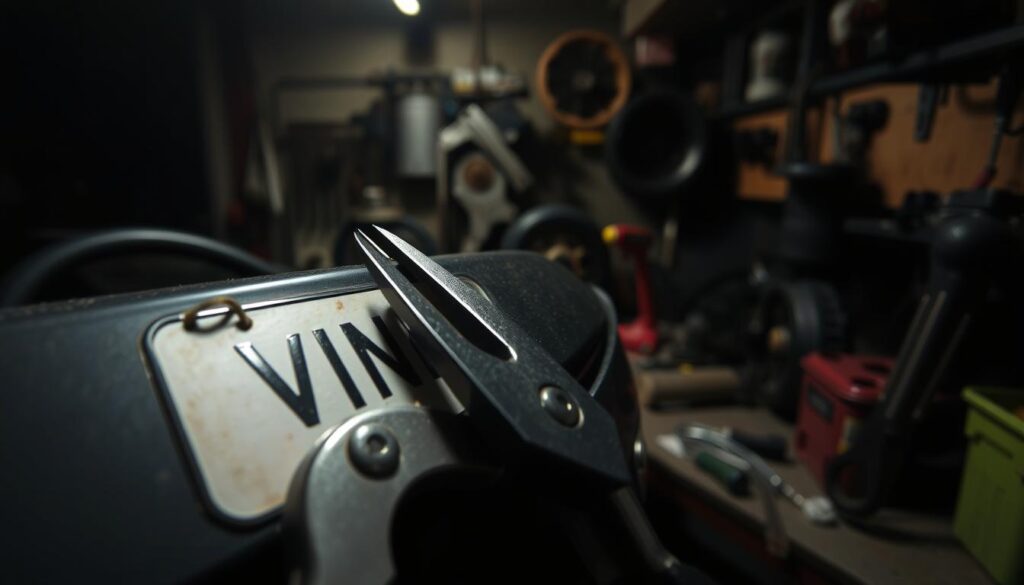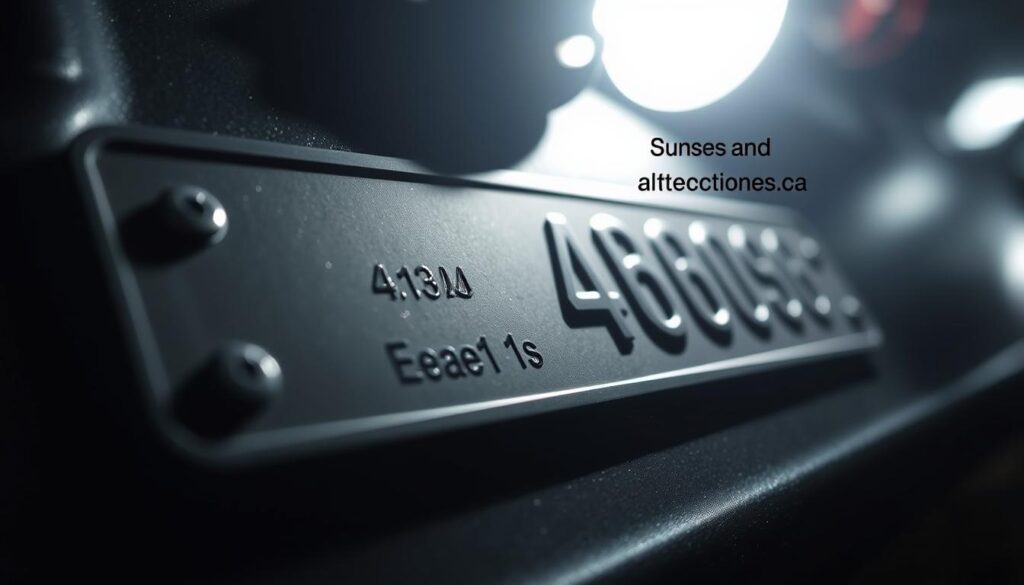Vehicle theft is a major problem in Canada. About 80,000 cars are stolen yearly, with many cases involving VIN tampering. This issue has serious legal consequences.
Canadian law takes VIN modification very seriously. The Criminal Code’s Section 353.1 addresses this issue. It’s illegal to alter, remove, or erase a vehicle’s VIN without a valid reason.
The penalties for VIN tampering are severe. If caught, you could face up to five years in prison. This shows how seriously Canadian authorities view this crime.
Knowing vehicle ID laws is crucial for everyone. This applies to used car buyers and auto salespeople. Our guide explains the rules that protect vehicle identity across Canada.
What Vehicle Identification Numbers Mean in Canada
In Canada, Vehicle Identification Numbers (VINs) are crucial for tracking and identifying motor vehicles. They serve as a unique identifier throughout a vehicle’s life. VINs help maintain the integrity of Canada’s automotive market.
Purpose and Importance of VINs
VINs act as a vehicle’s digital fingerprint, similar to human DNA. They stay with the vehicle from production to scrapping. VINs serve multiple critical purposes in the Canadian automotive ecosystem.
VINs are important for ownership verification, vehicle history tracking, and facilitating manufacturer recalls. They also help prevent theft, recover stolen vehicles, and detect insurance fraud and odometer tampering.
This standardized system makes it harder to hide vehicle history. It protects Canadian drivers and maintains trust in the used car market.
Standard VIN Format and Components
Canadian vehicles use the international 17-character VIN standard (ISO 3779). Each character in this code reveals specific information about the vehicle’s origin and specs.
| VIN Section | Characters | Information Provided | Example |
|---|---|---|---|
| World Manufacturer Identifier | 1-3 | Country, manufacturer, and division | 2HG (Honda made in Canada) |
| Vehicle Description Section | 4-8 | Model, body type, engine, restraint system | FC2E5 |
| Check Digit | 9 | Mathematical verification code | 7 |
| Vehicle Identifier Section | 10-17 | Model year, plant code, production sequence | JH123456 |
Primary and Secondary VIN Locations on Vehicles
Knowing where to find a vehicle’s VIN is crucial for verification. In Canada, manufacturers place VINs in standard locations for consistency and accessibility.
Primary VIN locations include the driver’s side dashboard and door jamb. They’re also found on vehicle registration and insurance documents.
- Driver’s side dashboard, visible through the windshield
- Driver’s side door jamb or door post
- Vehicle registration and insurance documents
Secondary VIN locations help prevent VIN cloning, where criminals copy legitimate VINs onto stolen vehicles. These hidden spots include:
- Engine block or firewall
- Frame rails or structural components
- Under the spare tire or in the trunk compartment
Multiple VIN placements make it harder for thieves to alter a vehicle’s identity. This helps fight VIN cloning operations across Canada.
Altering a Vehicle Identification Number: Legal Definition
Canada’s Criminal Code defines VIN alteration precisely. It helps distinguish between legal maintenance and criminal activity. This framework protects vehicles’ true identities.
The law covers various forms of tampering. It includes any identifying number or mark on vehicles.

Section 353.1 of the Canadian Criminal Code
Section 353.1 of the Criminal Code tackles VIN tampering. It’s the main tool for prosecuting automobile fraud involving identification numbers.
“353.1 (1) Every person commits an offence who, without lawful excuse, wholly or partially alters, removes or obliterates a vehicle identification number on a motor vehicle. (2) For the purpose of this section, vehicle identification number means any number or other mark placed on a motor vehicle for the purpose of distinguishing it from other similar motor vehicles.”
The Code allows exceptions for legitimate alterations. These include regular maintenance, repairs, or modifications for valid purposes.
Elements of the Offense
Prosecutors must prove four elements beyond doubt for VIN alteration. Each part is crucial in establishing the offense.
| Element | Description | Legal Significance |
|---|---|---|
| The Act | Altering, removing, or obliterating | Covers any physical or digital modification |
| The Target | Vehicle identification number | Any distinguishing mark or number |
| The Object | A motor vehicle | Applies to all categories of motor vehicles |
| Absence of Excuse | Without lawful excuse | No legitimate reason for the alteration |
All four elements must be present for conviction. Missing any single element prevents a conviction under this law.
Mens Rea Requirements
VIN alteration offenses require specific knowledge and intent. Canadian courts have ruled this isn’t a strict liability offense.
Prosecutors must prove the accused knowingly altered the VIN without lawful excuse. This separates criminal tampering from accidental damage during legitimate work.
The Crown must show the accused had:
- Knowledge that they were altering a vehicle identification number
- Intent to do so without legal justification
- Awareness that the alteration was not part of legitimate vehicle maintenance
Courts interpret “lawful excuse” in various contexts. Legitimate alterations require proper documentation and professional standards.
These legal definitions are vital for vehicle owners and professionals. They help combat automobile fraud in Canada.
Common Methods of VIN Tampering in Canada
VIN tampering in Canada has become a complex criminal enterprise. Perpetrators use sophisticated techniques to alter vehicle identities. The Criminal Code addresses various tampering methods, including altering, removing, or obliterating vehicle identification numbers.
Understanding these methods helps law enforcement and consumers identify potential fraud. Identifying tampered VINs is crucial for maintaining vehicle integrity and preventing illegal activities.
Physical Alteration Techniques
Physical alteration is the most direct approach to VIN tampering. Criminals grind down original numbers, use acid etching, and re-stamp new numbers to create false identities.
These alterations require specialized tools and metallurgy knowledge to appear authentic. Experts can often detect modifications through inconsistencies in font style, spacing, or stamping depth.
Skilled criminals target both primary and secondary VIN locations. They focus on hidden areas throughout the vehicle. Comprehensive inspection is crucial for detecting these alterations.

VIN Cloning Operations
VIN cloning is a sophisticated approach to vehicle identity theft. It involves duplicating legitimate VINs from registered vehicles onto stolen ones of identical make and model.
This creates automotive “twins” on Canadian roads, making detection challenging. Criminals obtain VIN information by photographing vehicles or purchasing history reports.
Law enforcement struggles with cloned vehicles as duplicated VINs appear valid in database checks. Only cross-referencing multiple identifiers can reveal these sophisticated frauds.
VIN Swapping and Transplantation
VIN swapping involves removing VIN plates from salvaged vehicles and installing them on stolen ones. This often includes transplanting entire dashboard sections, door pillars, or other components bearing identification numbers.
These operations frequently connect to larger criminal networks across Canada. Criminals carefully select donor vehicles from insurance auctions or salvage yards.
They match the stolen vehicle’s specifications to make detection more difficult. This method requires extensive knowledge of vehicle structures and dismantling techniques.
| Tampering Method | Complexity Level | Detection Difficulty | Common Tools Used | Criminal Code Violation |
|---|---|---|---|---|
| Physical Alteration | Moderate | Medium | Grinding tools, acid, metal stamps | Section 377.1(1)(a) |
| VIN Cloning | High | Very High | Computer equipment, printing technology | Section 377.1(1)(b) |
| VIN Swapping | High | High | Cutting tools, welding equipment | Section 377.1(1)(c) |
Criminal Penalties for VIN Alteration in Canada
In Canada, altering a Vehicle Identification Number (VIN) leads to severe criminal penalties. The justice system treats VIN tampering harshly due to its links with organized crime. It’s also connected to car title fraud and salvage vehicle scams.

Federal Sentencing Guidelines
Canadian federal law classifies VIN alteration as a hybrid offense. This gives prosecutors flexibility in charging offenders. For major cases involving crime networks, they often proceed by indictment.
Less severe cases may be processed by summary conviction. This allows the justice system to respond based on each case’s specifics.
Maximum Penalties Under the Criminal Code
Section 377.1 of the Criminal Code of Canada outlines VIN alteration penalties:
“Punishment (4) Every person who commits an offence under subsection (1) (a) is guilty of an indictable offence and liable to imprisonment for a term of not more than five years; or (b) is guilty of an offence punishable on summary conviction.”
Indictable offenses can result in up to five years imprisonment. This reflects the serious nature of VIN tampering.
Summary conviction cases typically involve fines from $1,000 to $5,000. They may also include imprisonment up to two years less a day.
Aggravating and Mitigating Factors
Several factors influence sentencing severity in VIN alteration cases. Courts consider these elements when determining penalties for convicted offenders.
| Aggravating Factors | Impact on Sentencing | Mitigating Factors |
|---|---|---|
| Involvement in organized crime | Significantly increases penalties | First-time offender status |
| Large-scale operations | Pushes toward maximum sentences | Cooperation with authorities |
| History of similar offenses | Leads to consecutive sentences | Limited role in larger scheme |
| Connection to car title fraud | Compounds charges and penalties | Absence of financial harm to victims |
| Using altered VINs for salvage vehicle scams | Triggers additional fraud charges | Demonstration of remorse |
Canadian courts now lean towards stricter sentencing for VIN-related crimes. This is especially true when connected to organized crime operations. It shows growing awareness of VIN tampering’s role in broader criminal activities.
When buying a used vehicle, thorough VIN verification is crucial. It protects you from unwitting participation in criminal activity. It also shields you from losses linked to salvage vehicle scams and car title fraud.
Provincial Variations in VIN Tampering Enforcement
Canadian provinces have unique VIN verification systems to address regional challenges. While federal regulations set national standards, each province enforces its own mechanisms. These additional requirements help combat vehicle fraud effectively.
Ontario’s Approach to VIN Verification
Ontario has a rigorous VIN verification system. It requires mandatory checks for all out-of-province vehicles before registration. This helps maintain the integrity of the vehicle registration process.
Provincial inspectors receive special training to spot tampering signs. They learn to identify techniques used to hide vehicle history. This includes VIN plate swaps and frame changes.
The Ontario Provincial Police collaborates with the Ministry of Transportation. They have task forces targeting vehicle fraud groups. These efforts have improved detection rates for tampered vehicles significantly.
Quebec’s Anti-VIN Tampering Measures

Quebec uses unique methods to fight VIN fraud. They maintain a database tracking vehicle histories across jurisdictions. This makes it harder for criminals to hide problematic backgrounds.
The SAAQ oversees mandatory VIN etching programs. This places the ID number on multiple vehicle parts. It creates more barriers for those trying to alter a vehicle’s identity.
The Sûreté du Québec has specialized anti-theft units. These units focus on VIN fraud cases. They’re experts in detecting advanced tampering methods, including digital odometer rollbacks.
Western Provinces’ Enforcement Strategies
Western Canadian provinces have developed their own VIN verification approaches. These reflect regional challenges and priorities in preventing vehicle crime.
British Columbia’s Special Provisions
British Columbia uses IMPACT, a specialized unit targeting VIN tampering. It combines resources from multiple agencies to fight vehicle fraud effectively.
The province has unique VIN checks for high-risk vehicles. These include:
- Salvage vehicles being rebuilt
- Vehicles imported from outside Canada
- Vehicles with insurance claim histories
These targeted inspections help identify vehicles with altered identities. They’re useful in spotting attempts to mask damage or theft.
Alberta’s Vehicle Inspection Requirements
Alberta has a thorough out-of-province inspection program. It includes detailed VIN verification protocols. Certified inspectors must complete special training to detect tampering evidence.
The province has improved its inspection procedures recently. They now address odometer rollback fraud, which often happens with VIN tampering. Digital tools now support physical checks for better authentication.
These provincial differences create enforcement challenges and opportunities. They allow for strategies tailored to local crime patterns. However, they may also create gaps that criminals could exploit.
Canadian Law Enforcement Agencies Combating VIN Fraud
Canada has a strong network of law enforcement agencies fighting VIN fraud. These specialized units work together to protect consumers and businesses. They tackle complex automobile fraud that often crosses borders.
RCMP Auto Theft Units
The RCMP’s Auto Theft Units lead the federal response to organized vehicle theft. They employ forensic specialists trained to spot even the most complex VIN alterations.
RCMP investigators work with international partners to track cross-border vehicles with fake IDs. This global approach is crucial as fraud networks operate across multiple jurisdictions.

These units use advanced techniques in their investigations. They include undercover operations, digital forensics, pattern analysis, and surveillance of suspected facilities.
- Undercover operations to infiltrate chop shop operations
- Digital forensics to track online sales of stolen vehicles
- Pattern analysis to identify organized criminal networks
- Surveillance of suspected VIN tampering facilities
Transport Canada’s Regulatory Role
Transport Canada oversees Motor Vehicle Safety Regulations, setting standards for VINs. They provide the legal framework that enforcement agencies use in their investigations.
The agency keeps databases of compliant vehicles and works with manufacturers. They ensure proper VIN system implementation and use accurate info for safety recalls.
Transport Canada offers technical expertise to law enforcement during complex investigations. This help is vital when dealing with imported vehicles that may have fake documents.
Provincial Motor Vehicle Registries
Provincial Motor Vehicle Registries are the first defense against VIN fraud. Each province has its own registry with specific procedures for vehicle registration.
Registry staff get special training to spot suspicious documents and signs of tampering. They have protocols to work with local and federal law enforcement when they detect fraud.
Provincial registries use effective measures to combat fraud. These include mandatory VIN inspections, digital verification systems, and specialized equipment to detect alterations.
- Mandatory physical VIN inspections for out-of-province vehicles
- Digital verification systems that cross-reference VIN databases
- Historical record maintenance to track vehicle ownership changes
- Specialized equipment to detect physical alterations to VIN plates
| Agency | Primary Responsibility | Key Techniques | Jurisdiction |
|---|---|---|---|
| RCMP Auto Theft Units | Criminal investigation of organized VIN fraud | Forensic analysis, undercover operations | Federal/International |
| Transport Canada | Regulatory oversight and standards | Technical verification, manufacturer coordination | Federal |
| Provincial Motor Vehicle Registries | Registration verification | Document inspection, database cross-referencing | Provincial |
| Municipal Police Auto Squads | Local enforcement and chop shop raids | Surveillance, informant networks | Municipal |
Canada’s approach to fighting VIN fraud shines through successful joint operations. In 2022, a coordinated effort dismantled a major cross-provincial ring altering VINs on luxury vehicles.
This operation, “Project Identification,” led to 27 arrests and recovered vehicles worth over $15 million. It involved the RCMP, Ontario Provincial Police, and Quebec’s Auto Theft Unit.
Multi-jurisdictional approaches work well against complex fraud networks operating across provinces. By sharing intel and resources, Canadian agencies can spot criminal patterns more effectively.
Landmark Canadian Court Cases on VIN Tampering
Canadian courts have set important legal standards for VIN tampering cases. These rulings interpret Section 353.1 of the Criminal Code. They help legal experts and car owners understand how courts view these offenses.
R. v. Smith: Defining Intent in VIN Alteration
The 2008 R. v. Smith case changed how VIN tampering is prosecuted. It requires proof of two key elements: knowledge of VIN alteration and lack of lawful excuse.
Justice Williams stated that just having a car with an altered VIN isn’t enough for conviction. Prosecutors must show the accused knew about the change and had no legal reason for it.
This ruling made it harder for prosecutors and clearer for defense lawyers. The court’s view on “lawful excuse” is now central in VIN tampering trials.

Recent Prosecution Patterns
Prosecutors now link VIN tampering to larger criminal activities. They have a 67% conviction rate, with more success when digital evidence shows VIN cloning operations.
Courts give stricter sentences when tampering is tied to organized crime. Prosecutors use financial records, communications, and technical skills as evidence of intent.
Cross-Border VIN Fraud Cases
International VIN fraud cases are complex due to different laws. The 2019 R. v. Nguyen case showed how criminals exploit varied registration systems between Quebec and New York.
This case set a standard for sharing information between Canadian and American authorities. It revealed how criminals use differences in vehicle registration systems for fraud.
| Landmark Case | Year | Key Precedent | Impact on Enforcement |
|---|---|---|---|
| R. v. Smith | 2008 | Knowledge and intent requirements | Higher burden of proof for prosecutors |
| R. v. Nguyen | 2019 | Cross-border cooperation | Enhanced information sharing protocols |
| R. v. Patel | 2015 | VIN cloning as organized crime | Increased sentences for organized operations |
| R. v. Johnson | 2021 | Digital evidence standards | New protocols for electronic verification |
These cases have led to new laws, including standard VIN checks across provinces. The legal precedents guide how police handle complex VIN fraud schemes in Canada and across borders.
How to Detect Altered Vehicle Identification Numbers
Spotting an altered VIN requires specific techniques for Canadian car buyers. This skill helps avoid salvage vehicle scams and potential legal troubles. The Criminal Code defines VINs as unique identifiers for motor vehicles.
Verifying this crucial identifier can protect you from significant financial risks. Knowing how to check VINs is essential for any car purchase.
Visual Inspection Techniques
Examine the VIN plate’s physical characteristics carefully. Look for inconsistent font sizes or spacing between characters. Authentic VINs have uniform character spacing and consistent font styles.
Check for signs of physical tampering around the VIN plate. Look for unusual mounting screws or evidence of grinding. Many vehicles have VINs etched on multiple components.
Compare these numbers to ensure they match. Mismatched numbers often indicate a tampered vehicle.

Inspect the rivets or fasteners securing the VIN plate. Factory installations use specific types of rivets. Aftermarket or non-standard fasteners may suggest plate removal and reattachment.
Electronic Verification Methods
Modern technology offers powerful tools to verify VIN authenticity. VIN decoder apps can instantly confirm if the number matches the vehicle’s details.
Canadian buyers should use online databases like CARFAX Canada and CPIC. These services reveal if a vehicle has been stolen or has a salvage title.
Always cross-reference the physical VIN with electronic records before buying. Some manufacturers offer online verification tools specific to their vehicles.
Professional Authentication Services in Canada
For high-value vehicles or suspected fraud, professional authentication services provide expert verification. Certified inspectors can detect skillful VIN alterations using specialized equipment.
Many Canadian provinces have authorized inspection facilities for VIN verification. These facilities employ trained technicians who understand subtle signs of tampering.
Manufacturer-authorized dealerships can perform comprehensive VIN checks. Their technicians can verify if components match the vehicle’s original specifications. This service is valuable for luxury or collector vehicles.
Thorough VIN verification is your best defense against fraud. Proper authentication can prevent substantial costs associated with altered vehicle identification numbers.
VIN Tampering and Related Vehicle Crimes
VIN tampering in Canada often links to larger organized vehicle crime networks. The Criminal Code covers various vehicle-related offenses connected to VIN manipulation. These criminal groups have complex structures and international ties, making them hard to stop.
Law enforcement faces challenges in dismantling these sophisticated operations. They use specialized roles and advanced techniques to carry out their crimes. The scale of these networks extends beyond national borders.

Organized Auto Theft Operations
Modern auto theft groups in Canada work like efficient businesses. They have specialized staff and well-defined processes. Professional thieves use advanced tools to steal high-value cars quickly.
These operations often target models with strong export markets. They can steal a car in under a minute using electronic bypass equipment.
- Scouts who identify and track valuable target vehicles
- Technical specialists who defeat electronic security systems
- VIN tampering experts who create new identities for stolen vehicles
- Transportation networks that move vehicles across provincial or international borders
- Distribution channels for selling altered vehicles or their parts
The RCMP reports that theft rings target specific vehicles based on global demand. Luxury SUVs and trucks are often stolen in Ontario and Quebec. These vehicles get new identities through VIN tampering.
They’re then shipped to Eastern Europe, West Africa, and the Middle East. In these markets, the stolen vehicles fetch high prices.
Insurance Fraud Schemes
VIN manipulation plays a big role in complex insurance fraud schemes. These scams cost Canadian insurers millions each year. Fraudsters exploit the vehicle identification system in various ways.
Common insurance frauds involving VINs include:
- Owner-initiated theft reports for vehicles secretly sold to chop shops or exported illegally
- VIN swapping to disguise salvage or flood-damaged vehicles as undamaged ones
- Odometer rollback fraud combined with VIN manipulation to artificially inflate vehicle values
- “Title washing” across provincial boundaries to hide branded titles (salvage, rebuilt, etc.)
These frauds add $200-300 to every Canadian’s yearly insurance costs. Major insurers now have special units to fight this problem. They work with police to spot fraud through data analysis and inspections.
Chop Shop Networks in Canada
Chop shop operations show the large scale of vehicle theft in Canada. These illegal businesses process stolen cars in two main ways. They either take them apart for parts or change the VIN for resale.
A chop shop can process a stolen car in under 4 hours. The parts can be worth three times more than the whole car. They target high-value parts like catalytic converters and airbags.
Chop shops are often found in these areas:
- Urban industrial areas in the Greater Toronto Area, Montreal, and Vancouver
- Rural properties within driving distance of major urban centers
- Border regions facilitating cross-border trafficking
- Port-adjacent facilities supporting international export operations
Police now use smarter methods to fight these crime networks. They don’t just focus on single cases of VIN tampering. Instead, they use intelligence-led strategies to target entire operations.
These include surveillance, financial investigations, and working with international partners. They use Interpol’s stolen vehicle database to track cars across borders.
“VIN tampering is rarely the end goal—it’s a means to enable larger criminal enterprises that profit from vehicle theft, fraud, and parts trafficking. Our approach must target these networks comprehensively rather than addressing individual offenses in isolation.”
VIN tampering is just one part of a bigger criminal world. It helps thieves profit from stolen cars and parts. To stop this, police must tackle the whole system of vehicle crime.
By understanding how these crimes connect, law enforcement can better disrupt these criminal networks. This approach is more effective than dealing with each offense separately.
Protecting Yourself When Buying Used Vehicles in Canada
Buying a used car in Canada requires careful steps to avoid VIN fraud. Fraudsters use advanced techniques, so buyers must verify vehicle authenticity thoroughly. Proper checks can prevent financial loss and disappointment from purchasing a car with altered identity.

Mandatory VIN Verification Steps
Check multiple VIN locations on the vehicle for consistency. The dashboard VIN should match those on the door, engine, and frame. Any differences are cause for concern.
Compare physical VINs with those on all documents. The 17-character format should match the car’s make, model, year, and features.
Look closely at VIN plates for signs of tampering. Authentic plates have high-quality etching or stamping that’s hard to copy.
Using Canadian Vehicle History Reports
Get detailed reports from trusted Canadian services like CARFAX Canada. These show accident history, service records, and confirm legal ownership status.
Reports reveal issues sellers might hide, like accidents or odometer rollbacks. Watch for gaps in the vehicle’s history that could indicate problems.
Compare information across multiple reports when possible. This can highlight inconsistencies that need further investigation.
Red Flags That Suggest Potential VIN Fraud
Watch for these warning signs of VIN tampering:
- VIN plates that appear newer than the surrounding area or show signs of tampering
- Vehicle features that don’t match what the VIN decodes to (engine size, trim level, etc.)
- Suspiciously low pricing compared to similar vehicles in the market
- Sellers who resist providing complete documentation or block independent inspections
- Title documents with alterations, erasures, or inconsistent information
Have a qualified mechanic perform an independent pre-purchase inspection. Ask them to check for VIN tampering signs. Verify that all parts match the VIN’s specs.
Honest sellers won’t object to thorough checks. Be wary of those who rush you. They may be hiding issues with the car’s true identity or history.
Conclusion
Altering a Vehicle Identification Number is illegal in Canada. Section 353.1 of the Criminal Code states this offense can lead to five years in prison. VINs are crucial for vehicle tracking and safety recalls.
When VINs are tampered with, vehicles become untraceable. This can lead to various crimes, including insurance fraud and chop shop operations.
Canadian authorities work together to fight VIN fraud. The RCMP, Transport Canada, and provincial motor vehicle registries all play important roles. Their efforts have resulted in major legal cases.
Be cautious when buying a used vehicle. Verify the VIN and get a detailed vehicle history report. Look out for signs of potential fraud to avoid legal issues.
Everyone in the automotive market should be aware of VIN tampering. Understanding criminal techniques and legal consequences helps create a safer vehicle market for Canadians.

